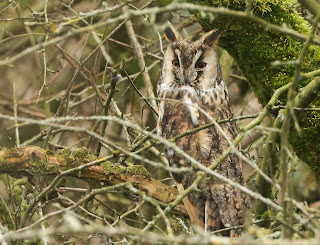I headed over to Martin Mere to try and see the overwintering Sibe chiffy, there has been up to an incredible seven Sibes here over the winter and last time I spoke to Damian who saw them a few weeks ago he said they were particularly showy birds too.,
He was right, I didn't have to wait too long before seeing one along the hedge close to the sewage works, a practically pale bird that stood out especially when it was next to a common chiffy as the Sibe variety omit the olive in the crown and mantle as well as the yellow in the underwing.
I counted at least two birds amongst the commons but they were moving and feeding continuously and being chased by the commons.
Brambling: The Janet Kear hide was still playing host to at least three brambling, two female and a male bird. Interesting to note that the male bird was only ever seen feeding on the feeders while the female birds spent more of their time foraging on the ground.
Male brambling are really nice birds with their darker tones around their heads and backs. The male was a little more elusive than the female birds and when it was on show it didn't spend as much time before flittering back into the undergrowth.
Tree Sparrow: There were also a couple of tree sparrow on the feeders amongst the usual stuff.



























